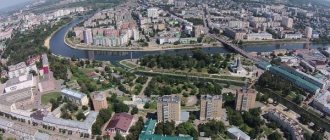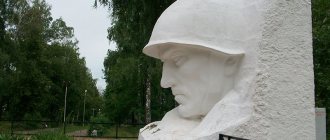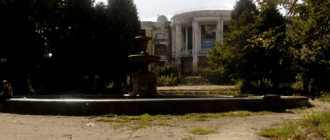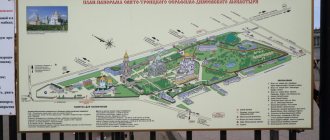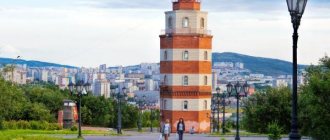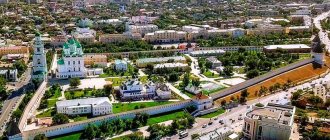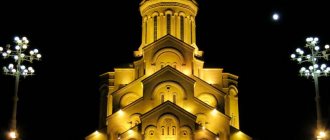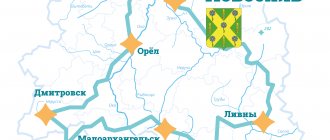Orel city. A story about a walk. Impressions of a tourist from St. Petersburg
This October we made our furthest weekend trip, going as far south as we could, and we reached the city of Orel. We left St. Petersburg on Friday evening, walked there on Saturday, and returned back on Sunday afternoon. The city turned out to be very nice - we came across a lot of old wooden houses, and we also saw a lot of churches of different architecture, and walked along the quiet embankment of the Orlik River. This article will tell you about the impressions the city left and what you saw. We went to Orel by train St. Petersburg - Belogorod. Seated carriages cost 2500, and seated carriages cost 1300, so we went there in a seated carriage. The carriage we came across was brand new, the seats were soft and upholstered in fabric. The carriage was made in St. Petersburg in 2002. The ride is very pleasant. We managed to sleep at night, the seat back reclines, and our legs can be stretched out without any problems. At 9:30 we were at the Orel train station. Exit from the station. The architecture here is very beautiful. Reminds me of the Cameron Gallery in Tsarskoe Selo. The symbol of the city opposite the station. Monument to railway workers. A good sculpture, made with feeling. Nearby there are carriages from the Great Patriotic War. The monument is spoiled a little by the fact that the local authorities stuck Stalin’s name here, because it seems to them that it was necessarily written on every carriage, which speaks not of their knowledge of history, but of their ideas and desires. It is worth recalling that Orel recently distinguished itself by erecting a monument to Ivan the Terrible here - the only tsar who committed the genocide of the Russian people. And the carriage is quite historical - people were transported in them. Railway platform with a cannon and mortar. Tractor with a machine gun. His main task is to pull damaged or stuck equipment out of the field. But if necessary, he could join the fight. Locomotive. And a platform with a truck for Katyusha missiles. “E” class steam locomotives were developed in 1909, during the times of the Russian Empire. Here is an Er series locomotive - they started making them already in the 1930s, so this locomotive actually took part in the Great Patriotic War. But this particular one was built later, in 1951, and until 2022 it worked somewhere in Siberia, until it turned into a monument. Next to the station is the Iversky Temple, which is directly related to the railway theme. The fact is that it was built to the design of an engineer of the Moscow-Kursk Railway, and with funds raised by railway workers. So this church can be considered a temple for railway workers. The church was founded in 1899, consecrated in 1902. At that time, the “Russian style” (pseudo-Russian, neo-Russian) was in fashion, and this church was also built in this style. In 1923 the temple was closed. At one time it housed a railway school. We went inside. A large number of wood carvings caught my eye. Next we had a trip to the most interesting attraction of Orel - the Saburov Fortress in the village of Saburovo. Read the report if you haven't already. And after returning from there, we already went to explore the city itself.
One of the most popular genres among travel bloggers is describing other cities and ridiculing their shortcomings. Especially on this, Varlamov’s pop balabol flourished in his time. Don’t feed a Muscovite bread, but let him mock other Russian cities. It’s like we have such improvement under Sobyanin, but they don’t know how to live, hahaha. Negativity and humiliation of others are always very popular among the public, ratings are guaranteed. In my blog, I initially tried to notice the good in other cities, if possible. Because we need to learn from each other and adopt the best. And now just about this.
I have long noticed - both in Tula and Ryazan - that stray dogs with tags on their ears walk along the streets. No one touches them, no one is afraid of them. Because they are vaccinated, they will not infect dangerous diseases, they are sterilized and are not aggressive. In Orel I saw this most clearly. Dogs friendlyly huddle up to people standing at the bus stop. They play happily on the lawns. No one throws hysterics about dog poop and the supposed danger from dogs, or regularly disperses waves of negativity about animals, as is customary in the capitals. Dogs will prevent wild animals from entering the city, which can bring dangerous infections. Oh, and by the way, trees on the streets are not cut down either, I think this is interconnected. Where they live in harmony with animals, they appreciate nature on city streets. St. Petersburg and Moscow are breaking away from nature, trying to roll everything into concrete, set up ugly high-rise buildings, nature begins to inspire fear and hatred - hence the exaggerated aggressiveness towards animals. This certainly puts pressure on the psyche, which is why we have a lot of nervous, hysterical, depressed and angry people. The phenomenon of mental disorders in megacities has been known for a long time, but I think that separation from nature plays an important role in this - little contact with greenery, animals, birds.
The city of Orel sets an example for us to live harmoniously with the environment, and we should remember what we were like before, learn from smaller cities and return to our roots.
Particularly noteworthy is the large number of lush willows on the city streets. Here is one of them. Real jungle!
But transport cannot be praised. There are almost no large buses on the city streets. Only such small grooves walk. This one has a funny inscription “through Alyosha”, understandable only to locals. All the buses are overcrowded, people travel standing and in a crush, which cannot be considered normal at all. The price is a consolation - going to the suburbs from the center costs only 26 rubles, two times cheaper than in St. Petersburg. But still, transport here is bad. Buses run frequently, but getting a group on them is a problem.
Let's go for a walk along the streets of Orel. Hidden among the modern houses are many ancient houses. Here is one of them, brick. And next to it is a wooden one! Miraculously survived among the kingdom of stone. Stone house. It seems to be pre-revolutionary too. A beautiful house that belongs to “Stalinist architecture” - post-war buildings that imitated the ancient style. Move a little to the side and you can see many wooden houses. Mostly they are small. Many people have a round window under their roof—some kind of local feature. The house still has a courtyard behind a wooden fence, where a gate leads. Everything is just like in the old days. Nearby are ancient wooden doors. There are almost no such places left in St. Petersburg. There are also old houses in various states of preservation. Some look better, some look worse, but there is no devastation among the old houses anywhere, unlike Ostashkov or Vologda, where a significant part of the wooden buildings burned down or collapsed. Some old piece of iron is sticking out. One-story old wooden house. Cozy wooden house. It's probably good to live in this. More wooden houses. A yellow gas pipe goes to the green house. They no longer burn wood there. An ancient two-story house. The lower floor is stone. Another house with a round window that resembles an eye. It is joyful to see the houses inhabited and the streets in good condition. By the way, mountains of garbage, bottles, and cigarette butts are not visible on them, and that’s good! Very beautiful street! The ancient appearance of a provincial town has been preserved here. Small houses do not block the sky, so there is a lot of light in such places. And green trees on the streets provide fresh air. There are a lot of churches in Orel, and their domes are clearly visible above the small houses. You don’t have to think too much about the route, just walk around the city center, and you will always come across some old church. Church of the Life-Giving Trinity and St. Basil the Great. Built during the reign of Empress Elizabeth Petrovna, around 1743. There was a belfry with her, which is now lost. The church was undergoing renovations inside. But it was possible to get into the lower temple. The lower temple was used in winter and is smaller and easily heated. The top one was in the summer, it was not heated. The Cathedral of St. Michael the Archangel is located very close by. There were a lot of cars and people here. It seems that this is a very popular temple in the city. I didn't take pictures inside, it was too crowded. And there is something to look at - many icons, gold frames, a lot of decorations, there was even a statue of Christ. But I took a few pictures outside. The temple was built under Emperor Alexander the First, between 1801 and 1817. Classicism was in fashion then. Every provincial Russian city tried to build a beautiful bell tower, and Oryol was no exception. And this is good, because it allows you to admire the architecture in almost any old city. And bell towers were always built beautifully, because they can be seen from afar. The only shot I took inside. It gives some impression of the beauty and luxury of the cathedral. We walk along the embankment of the Orlik River, which flows towards the Oka River, so that it will soon connect with it. The embankment has been cultivated and is pleasant to walk along. Aleksandrovsky (from 1919 - Leninsky) bridge. Built in 1880 under Emperor Alexander II. It was blown up by the Germans in 1943 and rebuilt after the war. There was vehicular traffic on the bridge, but by the 2000s it had become dilapidated and was restored, after which it became pedestrian. And this is actually very cool - it fits perfectly into the pedestrian promenade space. True, the locals don’t just walk here. But they also paint it with inscriptions from all possible sides. What a sad staircase overgrown with grass. Cultivation and ennoblement have not yet reached here. I went to look at the monuments near the embankment. This is a monument to the writer Leskov, who lived in Orel. And this handsome man is General Ermolov, the conqueror of the Caucasus. Beautiful monument! And fits harmoniously into the square. Well, this evil old man, who for some reason is swinging a cross, awkwardly sitting on a small horse, is Tsar Ivan the Terrible. He is sharply different from the handsome and brave Ermolov, even in appearance. And even more so internally. Ermolov fought defending Russian lands from the French, then conquered the Caucasus, expanding the Russian Empire. And Ivan the Terrible lost the Livonian War to smithereens, lost the original Russian lands, and also carried out massacres in ancient Russian cities, his guardsmen killed hundreds of women and children, the lands were empty, Volkhov was red with blood. A degenerate tsar, to whom no one erected monuments in the Russian Empire, but the current government considered this possible. Which says a lot about the appearance of modern governors. Beautiful architecture. A rotunda gazebo on the other side of Orlik. There are not enough benches on the embankment; there is nowhere to sit. You can't really sit on granite in cold weather. But it's quite good for summer walks. Let us draw your attention once again - there is almost no garbage, although irresponsible youth here and there tweet something. A pedestrian bridge appeared in the distance. It's suspended. Built in 1967. Someone spoiled the view with an advertisement, which left a stub with a phone number. They also tried to stick something on the bridge supports. Paper advertisements, which have long been almost non-existent in other cities, are still found here. Dam on the Orlik River. Erected in 1967. Its purpose is unclear. Perhaps they did it just for beauty, so that there was an artificial waterfall under a beautiful pedestrian bridge. Waterfall, bridge and temple in the distance. Beautiful landscape! Cathedral of the Epiphany. Built in 1642-1646. This is the time of the reign of the very first tsar from the Romanov dynasty - Mikhail Fedorovich. At that time, Orel was not yet an ordinary city, but was a border fortress that had not yet lost its military significance. In 1837-1838, the temple was significantly rebuilt and expanded, hence the classical style. During Soviet times, the temple was closed twice; it was finally returned to the Orthodox in 2015. This is the oldest temple of Orel. The historical place is the confluence of Orlik and Oka. It was here that the Orel fortress was founded to hold back the raids of the steppe hordes of the Crimean Tatars. This happened in 1566. Then a network of small fortresses appeared - outposts, which sent signals to Moscow about the approach of an enemy army. And if possible, they tried to delay him until reinforcements arrived. This process continued under Boris Godunov, who founded several powerful fortresses; under the first Romanovs, abatis lines were built from trees, which were a barrier for the mounted army - much like the lines of anti-tank barriers were made in the 20th century. It became more and more difficult for the steppe inhabitants, who under Ivan the Terrible could easily burn down all of Moscow, to attack. Their aggression was finally stopped under Princess Sophia, when two campaigns of Prince Golitsyn took place, who could not take Crimea, but repulsed the desire to attack Russia. Under Empress Anna Ioannovna, the process was completed - Russia for the first time captured and destroyed Crimea, and there was no one else to attack us from there; soon Crimea became part of the Empire (under Catherine the Second). And the story of the confrontation with the Crimean Khanate began here. Monument to the liberators of Orel. Another example of Stalinist architecture, which imitated the ancient style. They write that this house was built using the foundations and walls of older houses that survived the war. Well, we crossed the Oka over the bridge. And they moved to the outskirts of the city. On the other bank we also came across small wooden houses. Another beautiful temple. This is the Akhtyrsky Cathedral. The church was built in the 1770s, the bell tower in the 1820s. It is interesting that, like the previous cathedral, this one was closed in the 1930s, when Stalin carried out a real massacre of priests, exterminating almost everyone throughout the country, and churches were also closed en masse. When the city was captured, both temples were reopened. When the city was liberated, it was inappropriate to close the churches a second time, so as not to spoil the joy of the liberation, and therefore they remained in operation. Railway bridge over the Oka River. We reached a cave on the banks of the Oka, where stone had previously been mined. Unfortunately, the cave turned out to be higher in difficulty than we thought. They climbed inside and crawled around the first room, where you could only sit, but not stand.
And then, into the labyrinth, there was a narrow hole where you had to climb about five meters. It is obvious that they climb here often and that further on there is a large dungeon. But I couldn’t afford to climb the narrow skinny path - it would take a lot of time, especially considering that I’m not very narrow... So we looked and went back. This is what the entrance to the quarries looks like. We walked back past the Holy Vvedensky Convent. But it was already dark, and we couldn’t photograph anything except the turret of the fence. At the station we went into a store. A happy local cat was sitting here. I bought him a bag of food, but when I came out, he was already eating a huge piece of meat that someone had treated him to. Once again we were convinced that in Orel they treat pets well. This means that good people live in the city. He who knows how to sympathize and care for the weak has harmony in his soul. The station is beautifully illuminated at night with the colors of the Russian flag. We went back in a reserved seat carriage because we needed a table for a mass tea party with cakes. Early in the morning the train stopped at Bologoye station, and I got out to get some air. And at the same time take a photo of the local steam locomotive in the morning light. This is where our journey ended. Original
